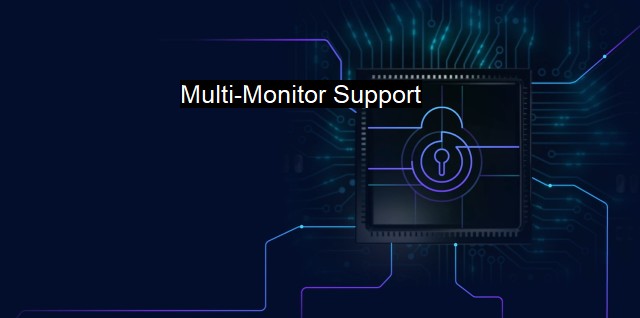What is Multi-Monitor Support?
The Benefits of Multi-Monitor Support: Boosting Productivity and Security Through Multiple Screens
As technological advances continue to redefine the landscape of cyberspace, it has become crucial for individuals and enterprises to be aware of certain glitches and deficiencies that may come with technology that can harm its utility or the confidentiality, integrity, and availability of outputs from such technology. One of these technical features that requires attention is multi-monitor support, especially in the context of cybersecurity and antivirus protection.Multi-monitor support, also known as multi-screen or multi-display, is functionality that allows a computer user to setup and use multiple simultaneously active physical display units on a single computer. This feature can cater to varying professional needs such as enhancing productivity, extending visual workspace, monitoring different types of content simultaneously, or for multimedia entertainment.
While the feature might come with some pleasant rewards, it could also pose some security challenges that necessitate cybersecurity controls and antivirus. It is important to note that numerous cybersecurity threats are made possible because of the multi-monitor support feature, threats that require both a proactive understanding as well as a robust defense and response strategy.
The major cybersecurity concern in the multi-monitor environment arises from graphic processing unit (GPU)-based attacks. Cybercriminals can exploit vulnerabilities in GPU to exploit leakages in application content and carry out malicious activities such as extracting sensitive data displayed across the monitors. This also forms a base situation for data breach scenarios, where the data leakage can pose a major downfall for a company's proprietary information flying out into the world of internet vulnerabilities.
Consider attacks like screen scraping and keylogging: monitoring software which was originally created as hacker tools to capture sensitive information from unwary users' screens, can equally perform these nefarious feats on a multi-screen display. Here, malwares are delivered to a network via emails or websites, subsequently infecting a system and enabling screen scraping on all connected displays.
To defend against such cybersecurity threats, a strong antivirus mechanism becomes essential. Antivirus software, that defends a single monitor, requires a similar strategy for a multiple-monitor setup, although the complexity increases due to increased points of attack. One way to go about this is applying context-based cybersecurity intelligence by taking real-time feed and correlating them through high-tech algorithms to generate alerts about anomalous activities across the screens. It foresees imminent threats and bolsters defenses accordingly to restrict malicious items from violating system security.
Employing an all-round cybersecurity policy aids in ensuring safe and secure utilization of the multi-monitor support feature. Compliance with software upgrades and employing application control, browser control, and in & out-bound firewalling can further bolster multi-screen data security.
Special attention is also needed for the 'Bring Your Own Device' (BYOD) movement. Employees coupling one or more monitors with their personal workstations for enhancing productivity space may detract from centralized cyber-defense infrastructure. With BYOD adoption soaring high, it is critical to employ decentralized antivirus protection to embed additional firewall and security layers.
The transition to multi-monitor setups should be approached carefully and with the right precautions. The roll-out should go hand-in-hand with containment and rollback techniques, together with the right balance of host intrusion detection and prevention systems (HIDS/HIPS). By taking this measured approach to cybersecurity and antivirus protection, multi-monitor setups can be run safely, productively and meet the organization's security requirements.
As businesses and personal computer usage evolve and multi-screen support becomes more available, organizations and individuals need to remain wary of the resultant cybersecurity threats and ensure adequate antivirus protection measures are in place. Equipped with reinforced security architecture, they can leverage multi-monitor settings, without the fear of jeopardizing critical data and system integrity, benefiting from secure runtime environments and safeguarded visual data narratives. The sculpture of technology, seemingly fascinating, when fortified with tight security measures, ensures end-users continue to enjoy the benefits technology offers, in this case, optimized productivity via multi-monitor support.

Multi-Monitor Support FAQs
What is multi-monitor support in the context of cybersecurity?
Multi-monitor support in the context of cybersecurity refers to the ability of antivirus software to work effectively across multiple screens. antivirus software that supports multi-monitor configurations is able to provide real-time protection on all screens simultaneously, ensuring comprehensive protection against cyber threats.Why is multi-monitor support important for antivirus software?
Multi-monitor support is important for antivirus software because it enables real-time protection across multiple screens, reducing the risk of cyber-attacks spreading across different screens. Without multi-monitor support, antivirus software may miss vulnerabilities on other screens, leaving the system vulnerable to cyber threats.What are the benefits of using antivirus software with multi-monitor support?
The benefits of using antivirus software with multi-monitor support include comprehensive protection against cyber threats across all screens, improved productivity, and the ability to quickly identify and respond to potential security risks. It also reduces the need for additional security layers that may compromise system performance.How can I ensure that my antivirus software supports multi-monitor configurations?
You can ensure that your antivirus software supports multi-monitor configurations by checking the software's documentation or contacting the vendor directly. Some antivirus software may require specific hardware or software configurations, so it's important to check compatibility before making a purchase.| | A | | | B | | | C | | | D | | | E | | | F | | | G | | | H | | | I | | | J | | | K | | | L | | | M | |
| | N | | | O | | | P | | | Q | | | R | | | S | | | T | | | U | | | V | | | W | | | X | | | Y | | | Z | |
| | 1 | | | 2 | | | 3 | | | 4 | | | 7 | | | 8 | | |||||||